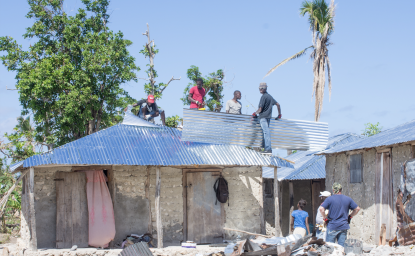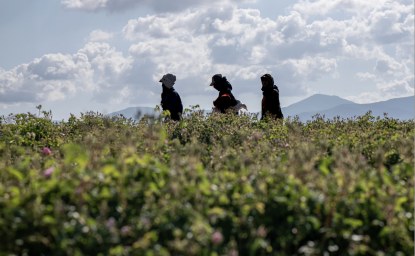<b>AIDS and War: Women in the Crossfire</b>
Jennifer Wisnewski Kaczor's article "AIDS and War: Women in the Crossfire" looks at how gender-based violence--including the transmission of AIDS--is being used as a tool of war.
Jennifer Wisnewski Kaczor's article "AIDS and War: Women in the Crossfire" looks at how gender-based violence--including the transmission of AIDS--is being used as a tool of war.
Women account for nearly 50 percent of AIDS cases worldwide. Out of 18.5 million women living with AIDS, 18 million of them live in developing countries, 15 million of whom are in sub-Saharan Africa. Equally alarming has been the increase in armed conflict, especially in developing countries, since the end of the Cold War. Disruption of services and the forced movement of people during armed conflict make conflict zones a ripe environment for the spread of STIs, especially HIV. Indeed, evidence suggests that civil wars and the subsequent movement of both troops and refugees contributed to the spread of HIV in Uganda, Mozambique and Angola. Why are women in conflict zones at particular risk for contracting HIV? And what are the programmatic responses necessary to address women who live in or near conflict zones?
Women, Gender-Based Violence & the Link to Conflict
Women are vulnerable at every stage of armed conflict, including the refugee process. During conflict and flight, women risk physical and sexual violence from soldiers and border guards, as well as from police and others in authority. In camp settings, women are at risk of both rape and sexual exploitation by fellow refugees, aid workers and local residents. Though sexual violence has been a consequence of war for centuries, the changing nature of conflict in the 20th century increases women's vulnerability to gender-based violence. These changes include: the increased number of armed conflicts in developing countries; the increased use of civilians — especially women and children — as military targets; and the increase in displaced peoples and refugees.
In some conflicts, gender-based violence is arbitrary and unsystematic; in other, more recent conflicts, the systematic rape of women and girls was a documented "tool of war". The Bosnian Wars and the genocide in Rwanda brought worldwide attention to the use of rape as a weapon of war. Estimates of the number of rapes in Rwanda range from 15,700 to over 200,000. Does gender-based violence during conflict make women more susceptible to AIDS? A 1997 survey in Rwanda found that three percent of women had been victims of rape, more than half of them during conflict. Rape survivors had an HIV prevalence rate of 17 percent while the general population had a prevalence rate of only 11 percent.
Risky Relationships
The U.S. Committee for Refugees estimates that there were approximately 34.8 million refugees and internally displaced peoples by the end of 2003. Refugee camps can be up to 80 percent women and children. Separated from their husbands, fathers and kin networks, exploitation through sexual bartering can become a way of life for women and adolescent girls who enter refugee camps with few possessions. An 18-year-old girl interviewed by Save the Children's U.K. staff indicates, "Many young girls displaced by the war are forced to sell themselves to survive. They don't say they have HIV because this would stop them from working." Women without male relatives are vulnerable to rape and sexual exploitation in exchange for necessities such as food, water and fuel. Separation from extended family, the breakdown of social norms, and the trauma of violence and war can also result in increased consensual sexual activity and risky sexual behaviors.
Research also shows that location does matter. Refugee camps near conflict zones have higher STI, including HIV, rates. In these cases, proximity to military, paramilitary and guerilla fighters may play a role. The military is a well-known vector of STIs. HIV prevalence rates within militaries in Africa have been estimated to be as high as 60 percent, and research indicates that HIV rates within the military are often two-to-five times higher than within the civilian population. Military personnel — like other mobile high-risk populations — often have disposable incomes, and are away from their own families, increasing the likelihood of risky behavior, such as hiring prostitutes. Women living either in conflict zones or in refugee settings may seek sex with military personnel as a way to elicit favors, necessities for their families, protection and income. This type of relationship makes it extremely difficult for women to negotiate condom use, if they or their partners even have access to condoms. Whether consensual or exploitative, without access to condoms or the ability to negotiate condom use, sexual activity in refugee settings can lead to the spread of the HIV virus.
Addressing Women's Vulnerability
It might be impossible to completely remove the risk of rape and increased risk of sexual exploitation for women living in conflict zones. National-level prevention and treatment programs that focus on access to condoms, improving negotiation skills with sexual partners, and reducing gender-based violence are necessary during peacetime to institute the behavioral change and cultural shifts that are necessary to reduce women's vulnerability at all stages of political stability or instability.
Guidelines for both the design and provision of reproductive health care in refugee settings have been established by the United Nations High Commissioner for Refugees and the United Nations Population Fund (UNFPA), in conjunction with NGO partners. The highlights of these guidelines include participation by the refugee community in designing camps so that they will reduce opportunities for sexual exploitation. The particular goal is to reduce the distance women and girls must go for water, fuel and food — times that both women and girls find themselves to be isolated and vulnerable to rape. UNFPA recommends that basic health care in camps should include access to condoms and emergency contraception, reflecting the realities of sexual violence and exploitation that are going on in camp settings. The Reproductive Health Response in Conflict Consortium (RHRCC) points out that, though guidelines are in place, the realities of camp design and service delivery difficulties undermine the full implementation of these guidelines in most camps.
Gender-based violence is a key link in the spread of AIDS in conflict zones and among populations in refugee settings. Through the Eleanor Bellows Pillsbury Fund, the Women's Commission for Refugee Women and Children targets programming at adolescents, utilizing peer training and counseling techniques for young women in refugee settings. Many of their programs target adolescent women, providing them with education about the transmission of STIs; better negotiating skills so their partners will wear condoms; and providing skills-based workshops, such as dressmaking or shoemaking, so that young women do not have to rely on sexual bartering with men.
Collaborating across Gender and Sector
An important and emerging trend in programming is looking at ways to specifically address men's behavioral change — key both to reducing sexual violence against women and increasing condom usage. Given their high rates of HIV infection, programs aimed at military personnel are one group that public health workers in conflict zones have focused on. Military personnel should receive HIV testing before deployment, HIV prevention training, gender awareness training and condoms. Most countries do not test their personnel before deployment, and have very few resources available for prevention education and treatment. This lack of capacity within developing country militaries places civilians, military personnel and their families at risk for contracting HIV, as well as other STIs. The United States Department of Defense has a small program aimed primarily at African ministries of defense to help improve their capacity for HIV prevention training. In partnership with Family Health International, the Civil-Military Alliance for HIV & AIDS and others, training materials have been designed to specifically address HIV prevention. Over 27 countries have implemented these trainings to some degree as of 2003, but money does not cover testing or treatment, which are both keys to scaling up these programs successfully and making them part of the overall country strategy to prevent and reduce HIV prevalence rates.
In addition to programming that focuses on HIV prevention in high-risk male populations, state-of-the-art programming takes a multi-sectoral approach and addresses strategies across sectors to deal with gender-based violence. This approach includes full engagement of the refugee community; interdisciplinary and inter-organizational cooperation; as well as collaboration and coordination among segments, such as the health, social, legal and security sectors. This approach relies on a commitment from national-level leadership to address gender-based violence. Major challenges in implementing these types of programs will be data collection, collaboration, and building national-level strategies and policies to create a favorable policy environment.
"AIDS and War: Women in the Crossfire," was originally published in the Global Health Council's April/May 2004 (#85) issue of Global AIDSLink, thematically dedicated to the feminization of HIV/AIDS. To read the rest of the issue, please
click here.

The Environmental Change and Security Program (ECSP) explores the connections between environmental change, health, and population dynamics and their links to conflict, human insecurity, and foreign policy. Read more



